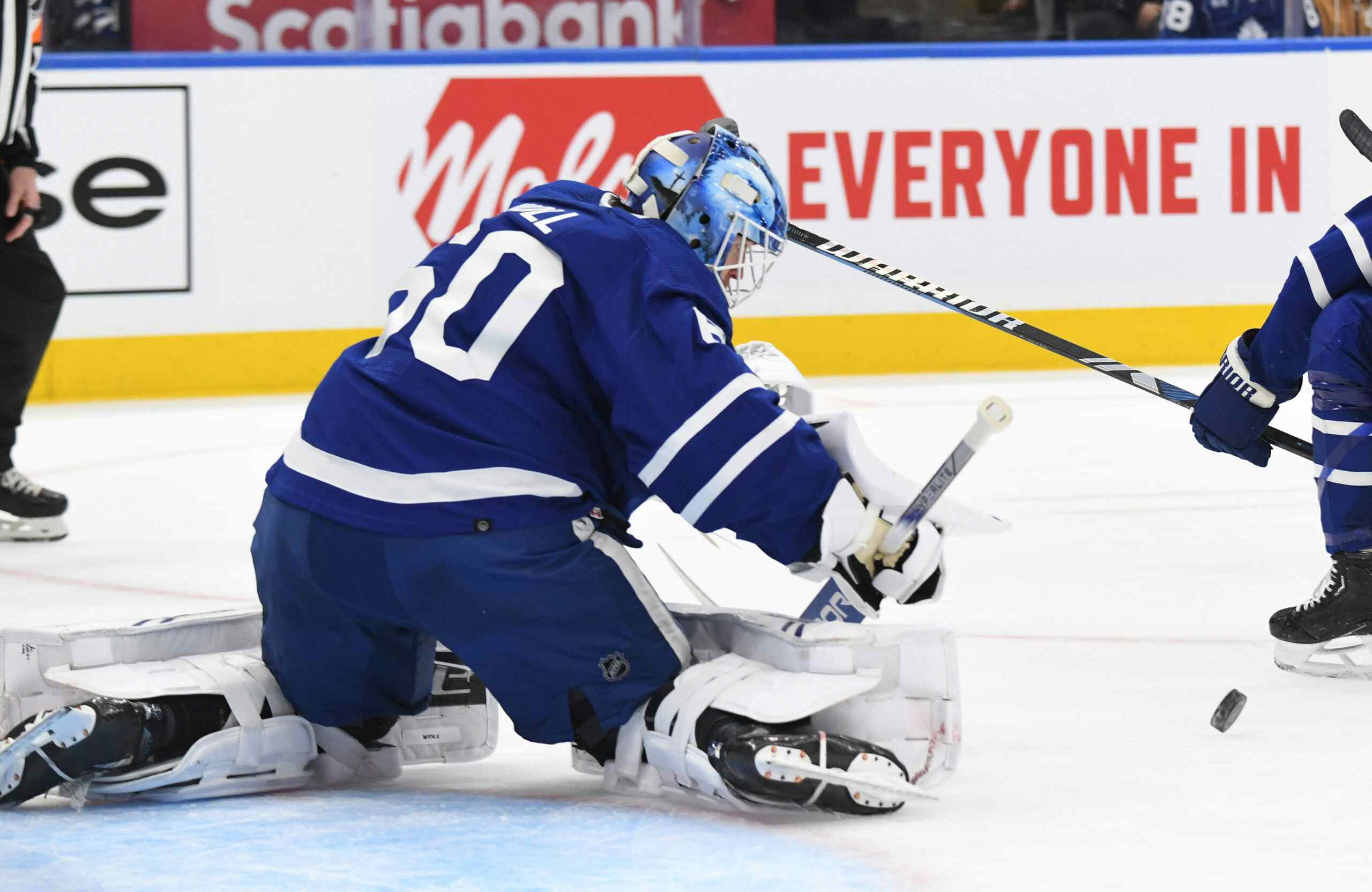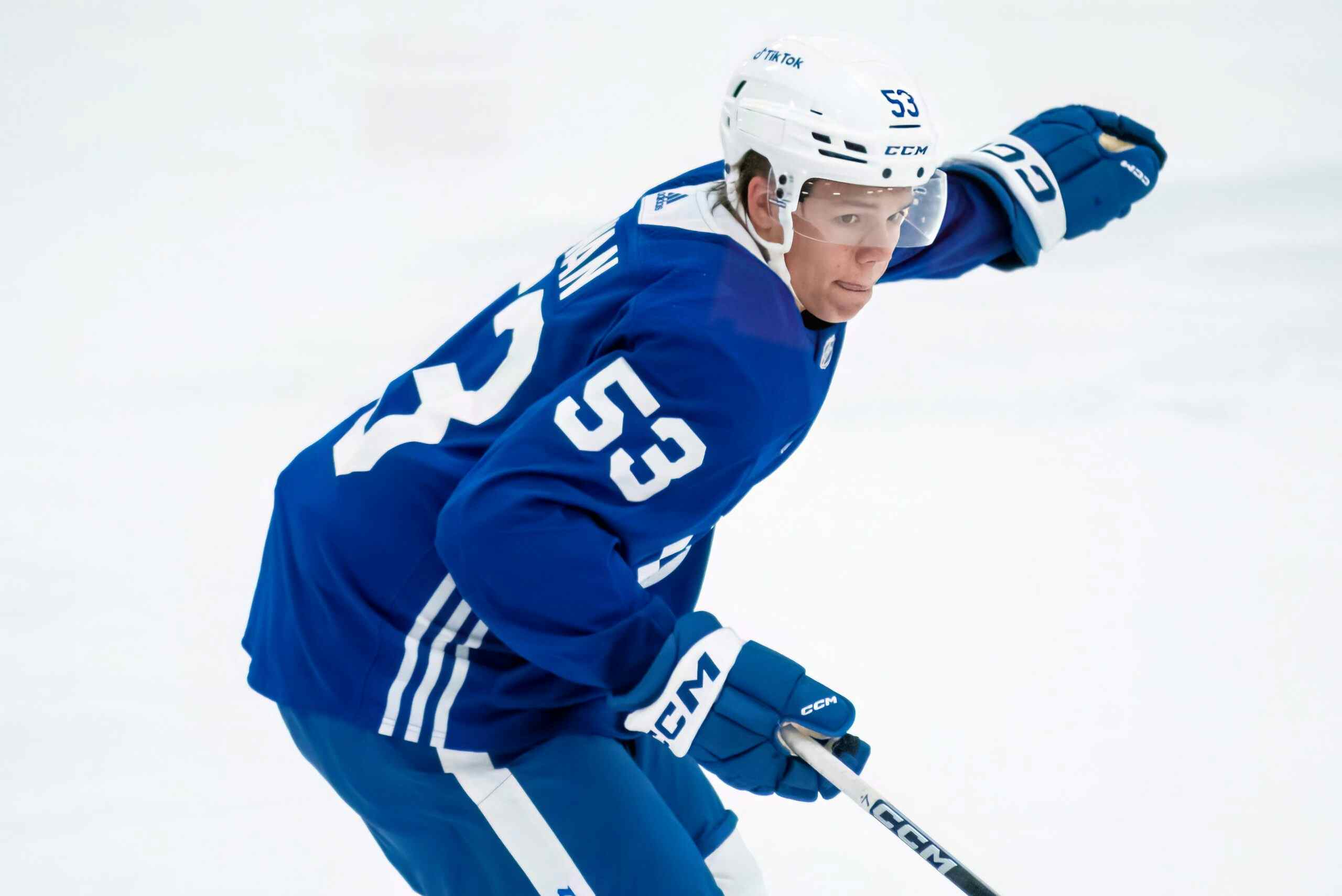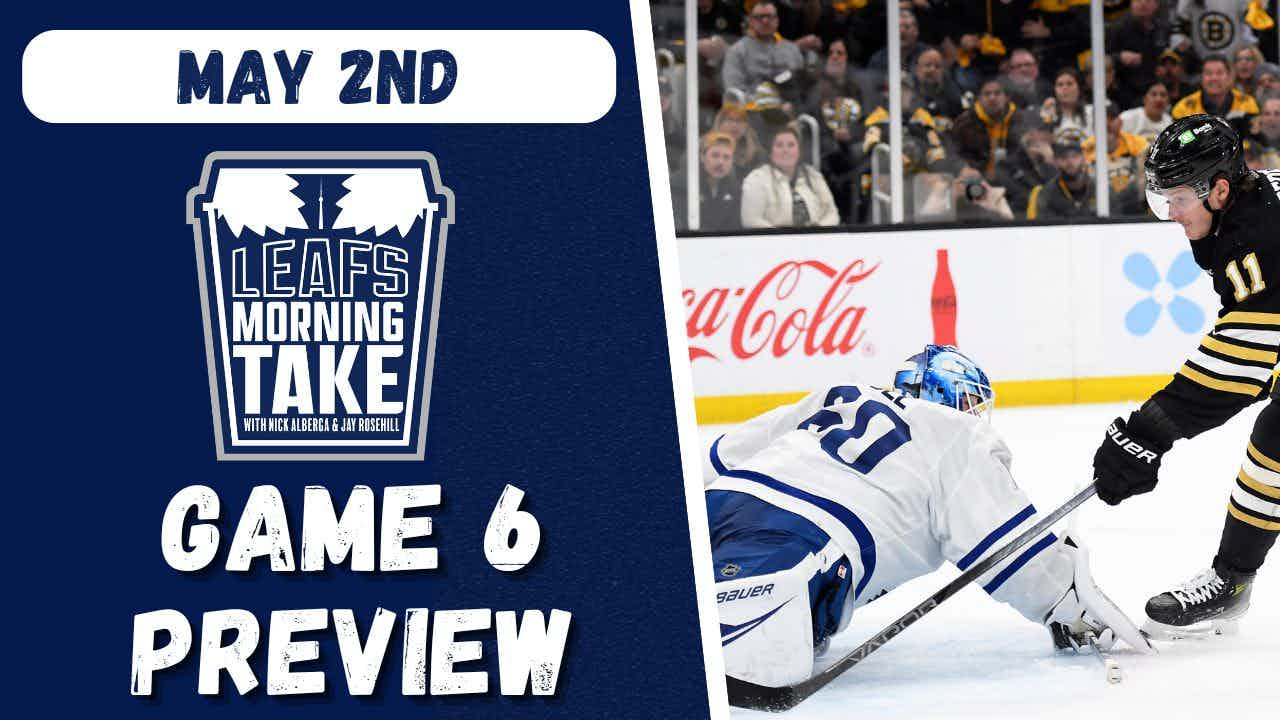Marlies Year In Review: Goaltending Wrap-Up

Photo Credit: Christian Bonin/TSGPhoto.com
Goaltending is often called the most important position in hockey, and it’s hard to dispute that. Position players can affect the course of the game when they’re on the ice, but outside of a few big moments a year, no individual is looked upon to win or lose his team the game. A goalie, however? They can change the course of the competition every two minutes or less.
In the case of the Toronto Marlies, they may have had some of the hottest sticks in the AHL this year, and that helped them achieve success, but being able to pair it with support from a shockingly long list of netminders was what kept this team on top of their world for as long as they were.
Regular Season Core Numbers
| Player Name | GP | Min | GA | GAA | W | L | OTL | SVS | SV% | SO |
|---|---|---|---|---|---|---|---|---|---|---|
| Antoine Bibeau | 40 | 2354 | 106 | 2.7 | 28 | 9 | 1 | 1064 | 0.909 | 3 |
| Garret Sparks | 21 | 1212 | 47 | 2.33 | 14 | 4 | 3 | 602 | 0.928 | 3 |
| Rob Madore | 4 | 240 | 5 | 1.25 | 4 | 0 | 0 | 99 | 0.952 | 1 |
| Jonathan Bernier | 4 | 240 | 5 | 1.25 | 3 | 0 | 1 | 91 | 0.948 | 3 |
| Alex Stalock | 3 | 181 | 8 | 2.66 | 1 | 2 | 0 | 78 | 0.907 | 0 |
| Ray Emery | 3 | 178 | 8 | 2.69 | 2 | 1 | 0 | 70 | 0.897 | 0 |
| Kasimir Kaskisuo | 2 | 125 | 5 | 2.4 | 1 | 0 | 1 | 48 | 0.906 | 0 |
| Ryan Massa | 1 | 60 | 1 | 1 | 1 | 0 | 0 | 16 | 0.941 | 0 |
The Others
- Rob Madore was brought in by the Marlies to be to be Orlando’s veteran side of their goaltending duo, and it worked out pretty well for them; the 28-year-old posted a 0.913 save percentage over 37 games. He did find himself playing for his version of a big club, though, getting four games in with Toronto. He was excellent too, allowing no more than two goals in any of his appearances and posting a shutout on January 8th against Manitoba.
- Ryan Massa was the other half of the Solar Bears’ two-headed beast, and he also looked good in his single game look. He stopped 16 of 17 shots in a 3-1 win over Syracuse on November 27th, missing out on a shutout by just 15 minutes. Massa originally joined the Leafs for training camp and impressed enough to get an ECHL deal in September. Considering his performances in his first pro year, it’ll be interesting to see if the 25-year-old returns this summer.
- Jonathan Bernier’s “conditioning stint” was one of the weirdest bits of news in the organization this year, but it was immensely entertaining to watch. The Leafs’ starter posted three shutouts in a row before taking his talents to Ricoh for a victory lap.. which ended in a more typical Bernier fashion. He gave up five goals, two of which came in the final 1:16 of his tenure. A huge peak and a swift valley, if you will.
- Ray Emery’s arrival showed the world that the Leafs are willing to take a chance on “problematic” players if they feel that they can keep their attitude on the level during their stay. Now, it’s worth keeping in mind that Emery has a long-time connection with Marlies GM Kyle Dubas, but the risk of messing with a young locker room is always there and they felt confident that he wouldn’t be a problem. Emery ended up getting along with the group just fine, though he could have been a bit more helpful on the ice, posting the lowest numbers of any of the fill-ins.
- Alex Stalock was a causality in the James Reimer trade, having to move shop to a team that didn’t necessarily need him in his final contract year. He did manage to go between the pipes a few times, though, and ended up as the only Marlies goaltender to put up a losing record. Stalock was sent home near the end of the season so he could spend time with his family and prepare for the next chapter in his career.
- Kasimir Kaskisuo was signed by the Leafs out of the University of Minnesota-Duluth this spring with a look towards next year in mind. He did get a chance to show off his skills, though, playing two games in April against Syracuse. He won his debut with 26 saves on 29 shots and lost the second game in overtime with a statistically better 22-for-24 performance. Kaskisuo is likely the only member of this group who will play regular minutes with the Marlies next year, though it’s also possible that he ends up as Orlando’s starter if Toronto goes with a Sparks/Bibeau tandem again.
- Lastly, we can’t have a goaltending list without giving a shoutout to David Ayres. Ayres didn’t play a single game for the Marlies this year, but he signed two ATO’s this season, backup up Jonathan Bernier on December 4th and Antoine Bibeau on February 27th. Why is this important? Ayres is the Ricoh Coliseum Zamboni driver. He’s also a recreational goalie and has been often used as a fill-in during practices. But the constant shuffles that the team had this year led to some openings that couldn’t be quickly filled by Massa or Madore, leading to Ayres throwing on the jersey and hopping on the bench.
The Big Picture
Despite the team’s complete lack of a consistent goaltending lineup this year, the Marlies didn’t really falter as a result. Obviously, as the back stoppers of the first-overall team, the group amassed more wins than any other goaltending platoon, but their individual performances were strong as well. Emery was the only goalie to finish below the league average save percentage of 0.906, and collectively, the group were a 0.918 on the year, second to only Grand Rapids (0.923) and Ontario (0.928). Combine that with Toronto being a top half shot suppression team (29.71 against/game), and the group had the fourth-best GAA at 2.50.
The Battle

While nine goalies put on jerseys for the Marlies this year, the focus was largely placed on the two who did so the most in Antoine Bibeau and Garret Sparks. They’re the younger ones with names more established in the organization, and until Kaskisuo was signed, they were the only ones with any sort of perceived future.
Sparks’ call-ups with the Leafs meant that Bibeau played much more of the regular season, and Bibeau’s climb back from looking like one of the worst goalies in pro hockey in November got many excited about what he could theoretically do.
Even still, though, I don’t think that it’s a contest as far as which of the two is better right now. Bibeau’s big push involved a 0.915 save percentage from December on; not mind blowing, but much better than the league average. But the worst ten-game stretch that Sparks had this year was a 0.916, and he ended up nearly 20 percentage points clear of Bibeau by the end of the season.
As seen in their individual review posts, I split the data of their appearances to see if I could find patterns in small samples. Truthfully, Sparks outperforms Bibeau in just about every “performance after ___ situation” category, though Bibeau did have the edge in save percentage after either one or two days rest; oddly enough, that seemed to be both the best time to start him and the worst to start Sparks.
Beyond that, Sparks bounces back much stronger after having bad nights (0.928 after a 0.889 or below performance vs Bibeau’s 0.902), is more prone to keeping a streak going after a hot game (Bibeau is alarmingly sub-0.900 immediately after 0.950+ games), is better at immediate back to backs or extended multi-day breaks, and a variety of other splits. This speaks to the excellent year that he had, though Bibeau still absolutely deserves praise for (usually) performing well in his extended absences.
The Playoffs
| Name | GP | Min | GA | GAA | W | L | OTL | SVS | SV% | SO |
|---|---|---|---|---|---|---|---|---|---|---|
| Antoine Bibeau | 12 | 682 | 31 | 2.73 | 6 | 5 | 0 | 278 | 0.900 | 1 |
| Garret Sparks | 5 | 235 | 9 | 2.3 | 2 | 2 | 1 | 97 | 0.915 | 1 |
Knowing the statistical disparity between the two made watching the playoffs a little bit curious, especially when Sheldon Keefe broke free of the tandem and ran Bibeau for seven games in a row. To many, myself included, it was a very, very tough sell picking the goalie who was statistically lesser as your guy down the stretch.
In hindsight, though, there was some understandable logic.
- As mentioned above, Bibeau had the better numbers with one or two days rest, which is more in line with the playoff schedule than the weekend-driven regular season.
- Understandably, the team stuck with players that had been there throughout the year. As much as we love to be cruel and emotionless jerks with excel documents on this site, long-term morale is a touchy thing. Bibeau dragged the team through the bulk of the regular season and to lose his spot to Sparks, who got to spend time getting a taste of the NHL dream, doesn’t send a good message. This doesn’t just apply to the goaltending; it took injuries for the Marlies to get Andreas Johnson and Travis Dermott into the lineup once they joined the team.
- Bibeau started taking control in the Albany series, and Albany was a team he faired extremely well against in the regular season, and, in fact, the first four games of the series. Bibeau was 0.961 against them in the regular season, 0.931 in Games 2-5, and up to that point, 0.944 overall. Then Games 6 and 7 happened, and the collar tugging began.d
However, Toronto also ran with Bibeau for far too long, hoping that he would bounce back after the Game 6 loss to Albany. Outside of the Game 6 loss to Albany. Ultimately, his last six appearances involved a shutout and five sub-0.900 performances; an unfortunate encapsulation of his season. Perhaps it would have made sense to get Sparks more involved in the Hershey series; not having him play two full consecutive games during the run was definitely a little bit on the odd side. But there was a form of logic behind the process if you looked hard enough.
Closing Thoughts
Toronto’s long-term goaltending situation is a very peculiar one. It’s been years since they’ve added a near draft-age puck stopper. The data seems to imply that picking up undervalued early-mid 20’s goalies is the safest success route in the modern game, but at the same time, one would think there should be some sort of pipeline; even if it’s signing undrafted netminders to add some sense of young ECHL depth.
For now, Toronto’s hopes are in three relative unknowns. We know that Sparks and Bibeau are both capable of dominating games, but just as capable of losing control of them even after a couple of pro seasons. Sparks seems like the safest bet to turn that into an NHL career due to his multiple years of better performances and seemingly tougher mental fortitude, but even he’s a question mark, especially with injury history considered. Maybe Kaskisuo is better than we can all imagine and he’s saving his coming out party for his first full year. It’s hard to tell for sure.
As far as immediate performance goes, though, the team got their money’s worth between the pipes. Sparks posted elite numbers, Bibeau bounced back to be an above average starter, and though they needed half a dozen others to fill in at times, most of them held the fort quite well, whether they were an NHL starter in the midst of a confidence breakdown, an ECHLer trying to make a name for themselves, a has-been trying to go for one more ride or the Zamboni driver on the bench.
It was a consistently inconsistent year between the pipes and while it may have troubled the team in the last games, it was a lot of fun to watch unfold.
Previous Profiles
Recent articles from Jeff Veillette





